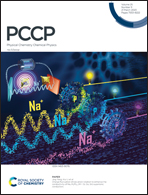Tuning the photochemical ring-closing reaction efficiency in diarylethene-based photoswitches through engineering of internal charge transfer†
Abstract
The photochemical quantum yield is one of the key features for a photoswitch and its tuning is challenging. In an attempt to tackle this issue within the popular diarylethene-based switches, we have explored the potential to use internal charge transfer (CT), a readily controllable parameter, for an effective modulation of the photocyclization quantum yield. For this, a homogeneous family of terarylenes, a sub-class of diarylethenes, with different CT characters, but the same photochromic core was designed and its photochromic properties were fully investigated. A clear correlation was found between the cyclization quantum yield and the CT character of the switch. More precisely, almost linear relationships were established between the ring-closing quantum yield and (i) the electron density variation accompanying the S0 → S1 transition and (ii) the percentage of LUMO on the reactive carbon atoms. Such a correlation was rationalized by a joint spectroscopic analysis and theoretical modelling of both ground and first excited states, introducing the concept of “early” or “late” photochromes. Encouragingly, such a potentally predictive model also seemed relevant when applied to some other diarylethene-based switches reported in the literature.

- This article is part of the themed collection: 2023 PCCP HOT Articles


 Please wait while we load your content...
Please wait while we load your content...